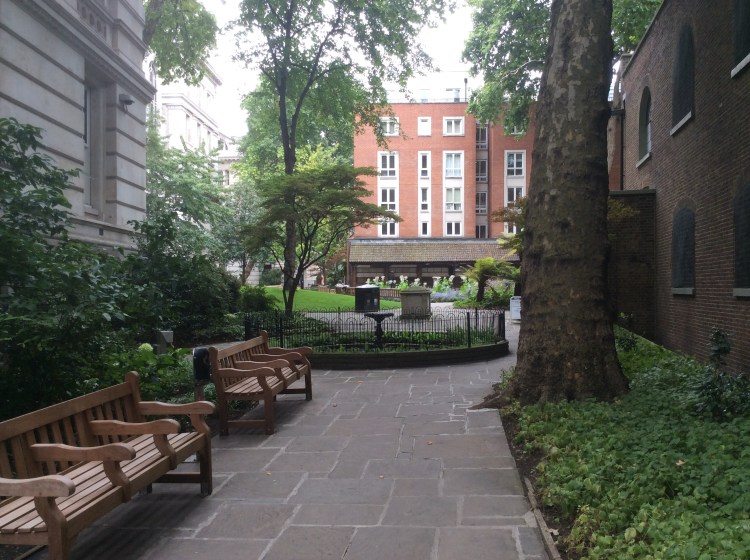One of the places I really enjoy visiting on my Secret Churches, Gardens and Ruins walk in the City of London is Postman’s Park.
The small park was converted in the 19th century from being a cemetery for the adjoining church and is largely unvisited by the swathes of tourists to London. Apart from the beautiful garden, trees and water feature, what really makes this small park stand out is the Memorial to Heroic Self-Sacrifice.

In September 1887 the Victorian artist George Frederic Watts (1817–1904) wrote a letter to The Times newspaper entitled ‘Another Jubilee Suggestion’. In this letter, he put forward a plan to celebrate Queen Victoria’s golden jubilee by erecting a monument to commemorate ‘heroism in every-day life’. On the 30th July 1900, this idea was eventually realised with the unveiling of his Memorial to Heroic Self-Sacrifice, situated in Postman’s Park in the City of London.
The monument consists of a modest wooden cloister, sheltering a short stretch of wall upon which are fixed fifty-four memorial tablets commemorating sixty-two individuals, men, women and children, each of whom lost their life while attempting to save another. The earliest case featured is that of Sarah Smith, a pantomime artist who died in 1863 and the latest is Leigh Pitt who drowned in 2007. The youngest individual commemorated is eight-year-old Henry Bristow; the oldest, sixty-one-year-old Daniel Pemberton.
There are many layers of meaning hidden beneath the timber and ceramic of the Watts memorial. On the surface it is fundamentally a narrative of remembrance, a record of those who might otherwise have been forgotten, and this was something that Watts had in mind when he created it. He also, though, intended the monument to be instructional and to offer examples of what he believed to be model behaviour undertaken by people of sound and decent moral character. When standing before the tablets, viewers were encouraged through the narratives provided to conceive the act of heroism as a product of an exemplary life rather than just a single brave moment. The message was not one of how to behave in the rare instance of being faced with disaster, but a blueprint for how to live as a respectable, honourable and purposeful citizen.
G. F. Watts was undoubtedly the driving force behind the monument and although his wife Mary was initially dedicated to fulfilling his legacy her involvement waned as other opportunities presented themselves. By 1929, when an attempt was made to reinvigorate the project, the social and cultural landscape of Britain had substantially altered and the moralistic tone that underpinned the memorial seemed out of date. There was little public engagement with the idea and consequently further installations were not pursued.
A meeting in 2010 involving representatives from all the significant interest groups reached a conclusion that it was no longer appropriate to add further tablets to the memorial. The reasons behind this decision were that the memorial was a personal project of G. F. Watts and his vision and influence were intrinsic to its character, that the memorial predated the modern honours system which now allows for posthumous recognition and that the historical integrity of the memorial would be further compromised by additional tablets
Whilst I can see their reasoning, I think it is rather sad and think it is a wonderful idea to memorialise heroes in this fashion. Despite that, it takes nothing away from the wonderful and reflective experience one gets from visiting Postman’s Park.








Actually there is a recently applied plaque.
LikeLike
This is lovely.
LikeLike
Reblogged this on sed30's Blog.
LikeLike
Reblogged this on Part Time Spotter.
LikeLike
I love the idea! There is too much self-gratification in the world and to know that history has given us people who are willing to give their own life to help others is amazing. We know Christ willingly gave His life for all, but most do not have that divine nature. Thanks for sharing. I’d love to visit there. Nancy
LikeLiked by 1 person
Yes, it is one of my favourite places that i visit. It is very refeshing to know that people have performed such courageous and selfless acts when all around us we are surrounded by people with more monetary and selfish urges.
LikeLike